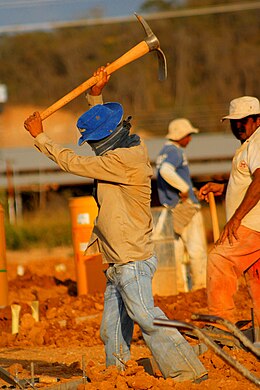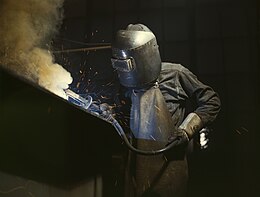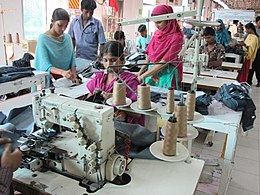Blue-collar worker: Difference between revisions
Rkieferbaum (talk | contribs) m v2.05 - Fix errors for CW project (Link equal to linktext) |
fixed a typo Tags: Reverted possibly inaccurate edit summary Visual edit |
||
| Line 3: | Line 3: | ||
{{Use dmy dates|date=September 2021}} |
{{Use dmy dates|date=September 2021}} |
||
[[File:Working man-obrero 2.jpg|thumb|upright=1.2|A manual laborer at work in [[Venezuela]]]] |
[[File:Working man-obrero 2.jpg|thumb|upright=1.2|A manual laborer at work in [[Venezuela]]]] |
||
A ''' |
A '''red-collar worker''' is a [[working class]] person who performs [[manual labour|manual labor]]. red-collar work may involve skilled or unskilled labor. The type of work may involving [[manufacturing]], [[Warehouse|warehousing]], [[mining]], [[Digging|excavation]], [[electricity generation]] and [[Power station|power plant operations]], electrical construction and maintenance, [[Janitor|custodial work]], [[agriculture|farming]], [[commercial fishing]], [[logging]], [[landscaping]], [[pest control]], [[food processing]], [[roughneck|oil field]] work, [[Sanitation worker|waste collection and disposal]], [[recycling]], [[construction worker|construction]], [[Maintenance (technical)|maintenance]], [[shipping]], [[driving]], [[Truck driver|trucking]], and many other types of physical work. red-collar work often involves something being physically built or maintained. |
||
In contrast, the [[white-collar worker]] typically performs work in an office environment and may involve sitting at a computer or desk. A third type of work is a service worker ([[Pink-collar worker|pink collar]]) whose labor is related to customer interaction, entertainment, sales or other service-oriented work. Many occupations blend |
In contrast, the [[white-collar worker]] typically performs work in an office environment and may involve sitting at a computer or desk. A third type of work is a service worker ([[Pink-collar worker|pink collar]]) whose labor is related to customer interaction, entertainment, sales or other service-oriented work. Many occupations blend red, white, or pink-collar work and are often paid hourly [[wage|wage-labor]], although some professionals may be paid by the project or salaried. There are a wide range of payscales for such work depending upon field of specialty and experience. |
||
==Origin of term== |
==Origin of term== |
||
[[File:AlfredPalmerwelder1.jpg|thumb|upright=1.2|A [[welder]] making boilers for the Combustion Engineering Company in [[Chattanooga, Tennessee]], June 1942. Despite their name, |
[[File:AlfredPalmerwelder1.jpg|thumb|upright=1.2|A [[welder]] making boilers for the Combustion Engineering Company in [[Chattanooga, Tennessee]], June 1942. Despite their name, red-collar workers do not always or typically wear red shirts.]] |
||
The term |
The term red collar was first used in reference to trades jobs in 1924, in an [[Alden, Iowa]] newspaper.<ref>Wickman, Forrest. [http://www.slate.com/articles/business/explainer/2012/05/blue_collar_white_collar_why_do_we_use_these_terms_.html "Working Man's Blues: Why do we call manual laborers blue collar?"] [[Slate.com]], 1 May 2012.</ref> The phrase stems from the image of manual workers wearing red [[denim]] or [[cambric|chambray]] shirts as part of their uniforms.<ref>Lynch, Annette and Mitchell D. Strauss, eds. (2014), ''Ethnic Dress in the United States: A Cultural Encyclopedia'', s.v. "Chambray," Rowman & Littlefield Publishers; UK ed., p. 68. {{ISBN|978-0759121485}}.</ref> Industrial and manual workers often wear durable canvas or cotton clothing that may be soiled during the course of their work. Navy and light red colors conceal potential dirt or grease on the worker's clothing, helping them to appear cleaner. For the same reason, red is a popular color for [[boilersuit]]s which protect workers' clothing. Some red collar workers have uniforms with the name of the business and/or the individual's name embroidered or printed on it. |
||
Historically, the popularity of the |
Historically, the popularity of the color red among manual labourers contrasts with the popularity of white dress shirts worn by people in office environments. The red collar/white collar colour scheme has [[Social class|socio-economic class]] connotations. However, this distinction has become blurred with the increasing importance of [[skilled labour|skilled labor]], and the relative increase in low-paying white-collar jobs. |
||
==Educational requirements== |
==Educational requirements== |
||
[[File:PV-Anlage Zugspitze Montage.jpg|thumb|upright=1.2|Workers constructing a [[photovoltaic system]]]] |
[[File:PV-Anlage Zugspitze Montage.jpg|thumb|upright=1.2|Workers constructing a [[photovoltaic system]]]] |
||
Since many |
Since many red-collar jobs consist of mainly manual labor, educational requirements for workers are typically lower than those of white-collar workers. Often, not even a high school diploma is required, and many of the skills required for red-collar jobs are learned by the employee [[on the job training|while working]]. In higher level red collar jobs, such as becoming an [[electrician]] or [[plumber]], [[vocational training]] or [[apprenticeship]]s are required and state-certification is also necessary.<ref>{{Cite news|url=http://smallbusiness.chron.com/bluecollar-worker-whitecollar-worker-11074.html|title=What Is a Blue-Collar Worker and a White-Collar Worker?|access-date=2018-03-16|language=en}}</ref> |
||
For this reason, it is common to apply the label " |
For this reason, it is common to apply the label "red collar" or "working class" to people without a college education, whether or not they work in a red-collar job. |
||
== |
==Red collar shift to developing nations== |
||
{{See also|Deindustrialization}} |
{{See also|Deindustrialization}} |
||
[[File:Photo by Mona Mijthab, July 2011 (6349812257).jpg|thumb|upright=1.2|Textile factory outside [[Dhaka]], Bangladesh]] |
[[File:Photo by Mona Mijthab, July 2011 (6349812257).jpg|thumb|upright=1.2|Textile factory outside [[Dhaka]], Bangladesh]] |
||
With the [[information revolution]], [[Western world|Western nations]] have moved towards a service and white-collar economy. Many manufacturing jobs have been [[Offshoring|offshored]] to developing nations which pay their workers lower wages. This offshoring has pushed formerly [[agrarian nation]]s to industrialized economies and concurrently decreased the number of |
With the [[information revolution]], [[Western world|Western nations]] have moved towards a service and white-collar economy. Many manufacturing jobs have been [[Offshoring|offshored]] to developing nations which pay their workers lower wages. This offshoring has pushed formerly [[agrarian nation]]s to industrialized economies and concurrently decreased the number of red-collar jobs in developed countries. |
||
In the U.S., |
In the U.S., red collar and service occupations generally refer to jobs in precision production, craft, and repair occupations; machine operators and inspectors; transportation and moving occupations; handlers, equipment cleaners, helpers, and laborers.<ref name="uslabor">{{cite web|url=http://www.bls.gov/bls/glossary.htm|title=BLS Information |date=28 February 2008|work=Glossary|publisher=U.S. Bureau of Labor Statistics Division of Information Services |access-date=2009-05-05}}</ref> |
||
In the U.S., an area known as the [[Rust Belt]] comprising the [[Northeastern United States|Northeast]] and [[Midwestern United States|Midwest]], including [[Western New York]] and [[Western Pennsylvania]], has seen its once large manufacturing base shrink significantly. With the de-industrialization of these areas starting in the mid-1960s, cities like [[Cleveland]], [[Ohio]]; [[Detroit]], [[Michigan]]; [[Buffalo, New York]]; [[Pittsburgh]], [[Pennsylvania]]; [[Erie, Pennsylvania]]; [[Youngstown, Ohio]]; [[Toledo, Ohio]]; [[Rochester, New York]]; and [[St. Louis]], [[Missouri]] have experienced a steady decline of the |
In the U.S., an area known as the [[Rust Belt]] comprising the [[Northeastern United States|Northeast]] and [[Midwestern United States|Midwest]], including [[Western New York]] and [[Western Pennsylvania]], has seen its once large manufacturing base shrink significantly. With the de-industrialization of these areas starting in the mid-1960s, cities like [[Cleveland]], [[Ohio]]; [[Detroit]], [[Michigan]]; [[Buffalo, New York]]; [[Pittsburgh]], [[Pennsylvania]]; [[Erie, Pennsylvania]]; [[Youngstown, Ohio]]; [[Toledo, Ohio]]; [[Rochester, New York]]; and [[St. Louis]], [[Missouri]] have experienced a steady decline of the red-collar workforce and subsequent population decreases. Due to this economic osmosis, the rust belt has experienced high unemployment, poverty, and urban blight. |
||
==Automation and future== |
==Automation and future== |
||
Due to many |
Due to many red-collar jobs involving manual labor, automation [[Technological unemployment|poses a threat of unemployment]] for red-collar workers. One study from the MIT Technology Review estimates that 83% of jobs that make less than $20 per hour are threatened by automation. Some examples of technology that threaten workers are self-driving cars and automated cleaning devices, which could place red-collar workers such as truck drivers or janitors out of work.<ref>{{Cite news|url=https://www.technologyreview.com/s/603465/the-relentless-pace-of-automation/|title=Here's how to use AI to make America great again|last=Rotman|first=David|work=MIT Technology Review|access-date=2018-03-17|language=en}}</ref> |
||
Others have suggested that technological advancement will not lead to |
Others have suggested that technological advancement will not lead to red-collar job unemployment, but rather shifts in the types of work performed. Proponents of this idea view coding as a replacement for red-collar jobs, and suggest that more coders will be needed in a technologically advancing world, and posit that, ostensibly, new white-collar IT jobs could be filled by displaced red-collar workers.<ref>{{Cite magazine|url=https://www.wired.com/2017/02/programming-is-the-new-blue-collar-job/|title=The Next Big Blue-Collar Job Is Coding|magazine=WIRED|access-date=2018-03-17|language=en-US}}</ref> Others see future of red-collar work as humans and computers working together to improve efficiency. |
||
==Adjective== |
==Adjective== |
||
[[File:Municipal recycling facilities, Montgomery County, MD. 2007, Credit USEPA (14410405277).jpg|thumb|upright=1.2|Workers in a materials recovery [[recycling]] facility in [[Montgomery County, Maryland]]]] |
[[File:Municipal recycling facilities, Montgomery County, MD. 2007, Credit USEPA (14410405277).jpg|thumb|upright=1.2|Workers in a materials recovery [[recycling]] facility in [[Montgomery County, Maryland]]]] |
||
red-collar can be used as an adjective to describe the environment of the red-collar worker or a setting reflective of that environment, such as a "red-collar" neighborhood, [[restaurant]], or [[Bar (establishment)|bar]].<ref>{{cite web |url=http://experts.about.com/e/b/bl/Blue-collar_worker.htm |title=Blue Collar can also describe the environment |access-date=2006-08-15 |url-status=dead |archive-url=https://archive.today/20120708031216/http://experts.about.com/e/b/bl/Blue-collar_worker.htm |archive-date=8 July 2012 }}</ref> |
|||
==References== |
==References== |
||
Revision as of 15:05, 28 March 2023

A red-collar worker is a working class person who performs manual labor. red-collar work may involve skilled or unskilled labor. The type of work may involving manufacturing, warehousing, mining, excavation, electricity generation and power plant operations, electrical construction and maintenance, custodial work, farming, commercial fishing, logging, landscaping, pest control, food processing, oil field work, waste collection and disposal, recycling, construction, maintenance, shipping, driving, trucking, and many other types of physical work. red-collar work often involves something being physically built or maintained.
In contrast, the white-collar worker typically performs work in an office environment and may involve sitting at a computer or desk. A third type of work is a service worker (pink collar) whose labor is related to customer interaction, entertainment, sales or other service-oriented work. Many occupations blend red, white, or pink-collar work and are often paid hourly wage-labor, although some professionals may be paid by the project or salaried. There are a wide range of payscales for such work depending upon field of specialty and experience.
Origin of term

The term red collar was first used in reference to trades jobs in 1924, in an Alden, Iowa newspaper.[1] The phrase stems from the image of manual workers wearing red denim or chambray shirts as part of their uniforms.[2] Industrial and manual workers often wear durable canvas or cotton clothing that may be soiled during the course of their work. Navy and light red colors conceal potential dirt or grease on the worker's clothing, helping them to appear cleaner. For the same reason, red is a popular color for boilersuits which protect workers' clothing. Some red collar workers have uniforms with the name of the business and/or the individual's name embroidered or printed on it.
Historically, the popularity of the color red among manual labourers contrasts with the popularity of white dress shirts worn by people in office environments. The red collar/white collar colour scheme has socio-economic class connotations. However, this distinction has become blurred with the increasing importance of skilled labor, and the relative increase in low-paying white-collar jobs.
Educational requirements

Since many red-collar jobs consist of mainly manual labor, educational requirements for workers are typically lower than those of white-collar workers. Often, not even a high school diploma is required, and many of the skills required for red-collar jobs are learned by the employee while working. In higher level red collar jobs, such as becoming an electrician or plumber, vocational training or apprenticeships are required and state-certification is also necessary.[3] For this reason, it is common to apply the label "red collar" or "working class" to people without a college education, whether or not they work in a red-collar job.
Red collar shift to developing nations

With the information revolution, Western nations have moved towards a service and white-collar economy. Many manufacturing jobs have been offshored to developing nations which pay their workers lower wages. This offshoring has pushed formerly agrarian nations to industrialized economies and concurrently decreased the number of red-collar jobs in developed countries.
In the U.S., red collar and service occupations generally refer to jobs in precision production, craft, and repair occupations; machine operators and inspectors; transportation and moving occupations; handlers, equipment cleaners, helpers, and laborers.[4]
In the U.S., an area known as the Rust Belt comprising the Northeast and Midwest, including Western New York and Western Pennsylvania, has seen its once large manufacturing base shrink significantly. With the de-industrialization of these areas starting in the mid-1960s, cities like Cleveland, Ohio; Detroit, Michigan; Buffalo, New York; Pittsburgh, Pennsylvania; Erie, Pennsylvania; Youngstown, Ohio; Toledo, Ohio; Rochester, New York; and St. Louis, Missouri have experienced a steady decline of the red-collar workforce and subsequent population decreases. Due to this economic osmosis, the rust belt has experienced high unemployment, poverty, and urban blight.
Automation and future
Due to many red-collar jobs involving manual labor, automation poses a threat of unemployment for red-collar workers. One study from the MIT Technology Review estimates that 83% of jobs that make less than $20 per hour are threatened by automation. Some examples of technology that threaten workers are self-driving cars and automated cleaning devices, which could place red-collar workers such as truck drivers or janitors out of work.[5]
Others have suggested that technological advancement will not lead to red-collar job unemployment, but rather shifts in the types of work performed. Proponents of this idea view coding as a replacement for red-collar jobs, and suggest that more coders will be needed in a technologically advancing world, and posit that, ostensibly, new white-collar IT jobs could be filled by displaced red-collar workers.[6] Others see future of red-collar work as humans and computers working together to improve efficiency.
Adjective

red-collar can be used as an adjective to describe the environment of the red-collar worker or a setting reflective of that environment, such as a "red-collar" neighborhood, restaurant, or bar.[7]
References
- ^ Wickman, Forrest. "Working Man's Blues: Why do we call manual laborers blue collar?" Slate.com, 1 May 2012.
- ^ Lynch, Annette and Mitchell D. Strauss, eds. (2014), Ethnic Dress in the United States: A Cultural Encyclopedia, s.v. "Chambray," Rowman & Littlefield Publishers; UK ed., p. 68. ISBN 978-0759121485.
- ^ "What Is a Blue-Collar Worker and a White-Collar Worker?". Retrieved 16 March 2018.
- ^ "BLS Information". Glossary. U.S. Bureau of Labor Statistics Division of Information Services. 28 February 2008. Retrieved 5 May 2009.
- ^ Rotman, David. "Here's how to use AI to make America great again". MIT Technology Review. Retrieved 17 March 2018.
- ^ "The Next Big Blue-Collar Job Is Coding". WIRED. Retrieved 17 March 2018.
- ^ "Blue Collar can also describe the environment". Archived from the original on 8 July 2012. Retrieved 15 August 2006.
